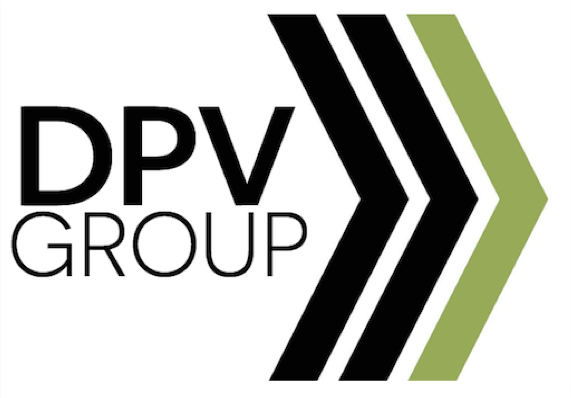An introduction to the market-focused philosophy, framework and methodology called Delivering Profitable Value (DPV)
By Michael J. Lanning
Managing Director and Founder, The DPV Group, LLC
This document describes the DPV framework and methodology – a market focused approach to strategy that is focused on generating breakthrough, profitable growth by discovering and delivering superior Value Propositions.
First, we will discuss the two more common models of strategic thinking and practice against which the DPV approach contrasts. These two kinds of behavior are called “Internally-Driven” and “Customer-Compelled.”
Classic Problem – the Internally-Driven Culture Most businesses tend to be “Internally-Driven,” eager for any rationale to stay with the apparent safety of their current strengths. Internally-Driven managers focus on designing, making and selling a product (or service) rather than on choosing, providing and communicating a superior Value Proposition. Competitive advantage is sought in the way products or services are made and sold, in assets, technologies, costs or functional skills that competition lacks. These managers often think from the inside out, deciding what product to make, then how to make it and then how to make customers buy it. All this is based on what they are good at, what they like to do, what’s in their safety/comfort zone – not based on what it would take to deliver profitable value in the marketplace. Functions (R&D, operations, marketing, regulatory, etc.), not integrated around any specific chosen Value Proposition, pursue their own inconsistent agendas (sometimes feuding and blaming each other), undermining the chances of delivering profitable value.
False Solution – the Customer-Compelled Culture In an attempt to transcend this Internally-Driven myopia, many pursue what they often see as the only alternative: commit to anything and everything customers suggest, the Customer-Compelled path. Just “be close” and “listen to” the customer, promise “total satisfaction” and “do what they say.” Marketing and total quality are often interpreted in these terms. Despite listening enthusiastically, the Customer-Compelled organization still fails to understand resulting experiences customers would really most value. It asks the same wrong questions that the Internally-Driven organization asks (how to make and sell what product?) but now it wants customers to answer.
Moreover, managers with this mindset try to use customer input alone to solve the whole business puzzle, giving inadequate attention to the relative abilities of the organization and to necessary trade-offs. While customers often make many good suggestions, they also suggest much that is neither actionable nor profitable. And the diversity of requests is limited only by the diversity of customers one encounters. Most organizations, trying to follow the Customer-Compelled path, find it impractical and are driven back toward the traditions of the Internally-Driven organization, disillusioned and discouraged.
Confusion Bridge – Balanced between two wrong paths? Many organizations find themselves engaged in a frustrating effort to blend the two flawed approaches. The result? Managers either do whatever the customer says unless it violates an InternallyDriven mandate, or they follow Internally-Driven agendas until a customer complains. This approach lulls some managers into thinking they have found some kind of balance, but this approach misses the fundamentals of DPV just the same
In this world of increasingly frequent and severe change, business organizations have a choice. They can adopt an Internally-Driven approach, a Customer-Compelled approach, an approach that combines the two, or the different and more realistic approach of DPV. Businesses on this least traveled road integrate all aspects of strategy, culture, and leadership around one objective: delivery of superior value to target customers at a cost allowing acceptable returns. This deceptively simple principle begins with a concept equally deceptive in its simplicity: the customer’s experience.
Customers’ Resulting Experiences: Essence Of A Real Value Proposition
Those who would make a business succeed face crucial decisions. Most important of these, yet most overlooked and poorly understood, is a disciplined choice of the experiences the business will cause some intended customers to have. These are the resulting experiences a business delivers, and they are the essence of a Value Proposition.
Properly understood, business is very much about the exploration and improvement of customers’ real business/life experiences. The traditional concepts of “needs, requirements and benefits” share important common ground with resulting experiences. However, the differences are considerable, as the conventional concepts focus too much on what the business does or on superficial, vague ideas of benefits or needs. Managers must learn to deeply understand and decisively act on specific experiences customers would most value.
Resulting Experiences in the microwave As an example, consider the experiences that result from using a microwave oven. Users typically cook some food in a pot in a traditional oven, then put it in a bowl, in the refrigerator. They later might put this food on a plate, reheat it in the microwave, and in about five minutes eat it; and it probably tastes good. To clean up, they wash the pot, bowl, and plate. Without the microwave, they would take the food from the fridge, put it in another cooking utensil, and reheat it for about 25 minutes in a traditional oven. The food might dry out, sticking to the utensil. They put the food on a plate and eat it; it may taste dried-out.
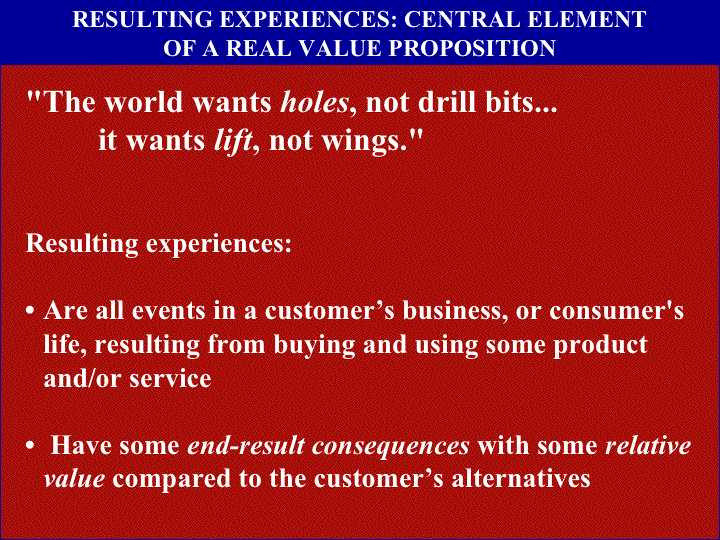
As a result of using the microwave, the user eats about 20 minutes earlier, does not wash the additional utensil (which may be difficult), and enjoys a better taste (not dried-out). These microwave experiences have some consequences better than the traditional oven experiences. These come with a tradeoff – the user must shop, find space, and pay the price for this microwave. Microwaves succeed because the value to customers of the resulting experiences, including drawbacks and price, was in net superior to alternative experiences.
Peel the Onion and keep asking, “So What?”
An event can be simple, like enjoying a consistently tender chicken dinner provided by a particular brand. However, the events in an experience may be complex, with one event leading to another. Managers must learn to peel the layers of the onion until they adequately understand the true end-result consequence in that experience.
To business users, for example, a laser jet printer delivered an experience consisting of a more complex series of events. Compared to dot-matrix printers, users could produce documents with darker, more contrasting blacks, and more sharply focused characters. This made users’ documents easier to read, and as a result, they communicated more effectively. If we peel the onion even further, it is reasonable to say that many users could use these more effective communications to persuade others more easily and thus could be more successful. In such a case, one must identify and describe the whole experience, including the entire series of related events as well as the end-result consequence. No one event (such as “makes blacker blacks” or “makes users more successful”) constitutes the whole experience.
Managers learning both to discover and to deliver resulting experiences to customers will find it helpful to ask, “so what?” If one can still ask this question about a resulting experience, the onion has probably not yet been peeled enough. There is likely a further consequence in this experience, not yet defined, which must be understood.
Resulting experiences are the essential core of a real Value Proposition.
A Value Proposition
To be actionable, the description of a Value Proposition must be specific and precise. So much so that this description must allow the organization to make meaningful trade-offs and set priorities throughout the functions and across all relevant resources and processes. A complete Value Proposition does not state a fuzzy aspiration; it completely and unambiguously commits the organization to its real delivery. It is therefore necessary to complete the choice of a Value Proposition by specifying the context in which the organization will deliver some set of resulting experiences.
Thus, choosing a complete Value Proposition requires an organization to make a set of interrelated decisions: Who are the intended customers and time horizon for this proposition? What do we want these targeted customers to do, and what is their competing alternative (what will they do if they don’t do what we want them to do)? Against the answers to these questions, what are the ‘resulting experiences’ that these customers will derive, that is, what will happen in their business and/or life, with what value compared to the alternatives? Note that price is one of these resulting experiences.
TRADEOFFS are important in many winning Value Propositions Some Value Propositions include resulting experiences that are inferior to competing alternatives.
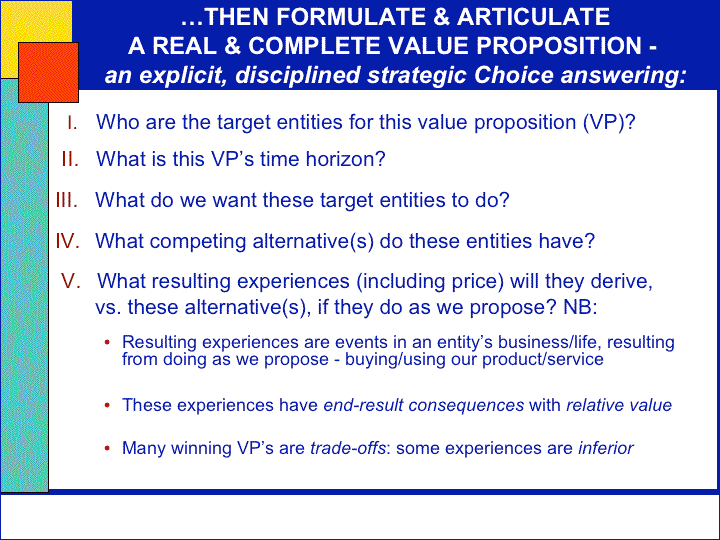
Manage A Business As A “Value Delivery System”
The Value Delivery System, and its central element, the Value Proposition, are meant as a replacement for the central framework that still strategic thinking. That framework, first described by McKinsey & Company as “The Business System,” was widely popularized as “The Value Chain” by Michael Porter’s Competitive Advantage.”
This traditional value chain, or business system, framework sees a business, in effect, as a product-supply system. It reinforces both Internally-Driven and Customer-Compelled thinking, as managers debate what perspective to use in answering the product-supply questions: “what product should we invent, how should we make it and how should we market it.” The Internally-Driven schools of thought want to answer these questions based on the organization’s resources and competencies. The Customer-Compelled schools want to ask the customer to answer these questions. But the faulty reasoning is in the questions themselves, not in who should answer them.
DPV changes the questions, to “what Value Proposition (that is, what combination of resulting experiences including price) should this organization deliver and how exactly should we align all products, resources and processes to profitably deliver it, that is, to provide and communicate each resulting experience?” The value delivery framework defines a business in different terms from the conventional paradigm; it defines a business in the terms of value delivery. From the DPV perspective, a market-focused business is a system integrated around delivery of a specific Value Proposition: a “Value Delivery System” that chooses, provides and communicates a specific Value Proposition.
Choosing the Value Proposition: To genuinely choose a Value Proposition is to make the central decision of business strategy, for a Value Proposition defines the precise objective of a business. If your organization has chosen one, then:
- You have a clear specific statement of it (not just a feeling)
- It represents a disciplined decision to pursue one of numerous options (not a vague global set of promises to be good and nice)
- Every function and department (not just marketing) understands it and uses it to closely guide their everyday operational decision-making.
Most don’t Most organizations do not in fact choose a meaningful Value Proposition. In these organizations, managers in different functions, when asked, would describe entirely different Value Propositions. Some may be at a loss to describe one at all. Often, choosing the Value Proposition is left for marketing and sales to do, once manufacturing and product development have finished with their important tasks. In this case, a Value Proposition is nothing more than an afterthought. In all of these instances, the Value Proposition has not been properly chosen.
The easier path – no real choice It should be recognized that, short-term, it is politically less disruptive in most organizations to adopt a supposed Value Proposition so innocuous as to offend no one. Also politically easy is for a small group of managers to select a specific one but not fully convey it to others in the organization, much less enforce it as strategy. Such Value Propositions are politically not very troublesome but also unlikely to have a great impact.
Of course choosing as defined here is only advisable in order to make more money. An alternative is to trust to luck and hope for the best. A small lucky minority of organizations does profitably enjoy customer preference, at least for a while, despite never deciding deliberately to pursue any real Value Proposition. Most organizations do not see themselves as randomly throwing the dice and praying. Many usually employ some Internally-Driven and/or Customer-Compelled assumptions to decide what products/services to offer and how. This only obscures the fact, however, that they are still not choosing a specific Value Proposition.
Providing the Value Proposition: Once chosen, the Value Proposition must actually happen in the life of the intended, target customer. That is, the business must actually provide the chosen resulting experiences to the chosen intended customer. A word of caution: issuing copies of the proposition to all departments (“Attention! Make this happen. Please.”) won’t work. Rather, an organization must explicitly decide how it is going to provide each experience.
Example: a hospital For example, a large Northern California hospital group articulated a proposition that focuses on obstetrics and includes among resulting experiences the notion that the consumer should receive “superior emotional well-being.” This means in part that she and her family: “understand what’s happening, what she and they can and should do to help the pregnancy; and, are included in medical decisions.” This specific resulting experience is provided by actions such as:
- Education proactively integrated into the pregnancy from the outset (versus simply making a few courses available and passing out some literature)
- Highlighting and discussing actions the mother can take to help pregnancy so she really understands options and consequences (e.g., diet, exercise, work habits, stress, etc.)
- Education for mother includes understanding the range of likely responses by her family and how she can best manage these (e.g., to minimize the first child’s jealousy)
Communicating the Value Proposition: In addition to providing each resulting experience in a chosen Value Proposition, a business must communicate these experiences as well. The business must ensure that target customers realize and fully appreciate the fact that doing what the business wants them to do will allow them to actually derive these resulting experiences. And the business must ensure that the customer appreciates the full value for them of those resulting experiences. Finally, the business must give the customer a reason to believe that they actually will derive those resulting experiences. No matter how well a business provides a Value Proposition, it must communicate it to actually win customer preference.
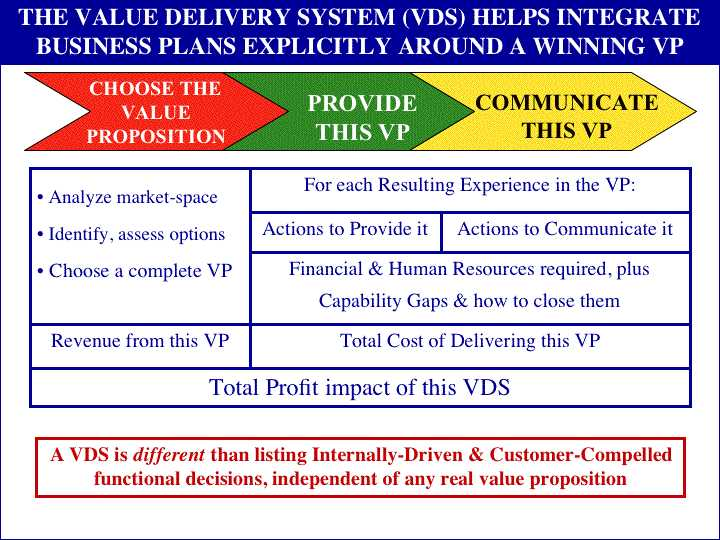
When Customers Have Customers: Understanding The Value Delivery Chain
Of course, some businesses are more complex than others. Often, intermediaries lie between the business’s organization and those customer-entities of most crucial importance to that business. The simplest example is a manufacturer selling to users through distributors, which are thus intermediaries. Those user-entities may also themselves be businesses with customers as well. Somewhere at the end of such a chain may be entities who are individuals, such as consumers. Thus, there exists a chain of interlocked entities, from the business’ suppliers through its intermediaries, its immediate customers and so on, to the last relevant entity. Some entities in the chain may be “offline” in the sense that they do not engage in buying or selling products relevant to the business but do influence players in the chain. Regulators or standard-setting bodies would be typical off-line entities.
Beyond Supplying Products/services Up to the final entity in the chain, the entities at all of these levels can be understood as Value Delivery Systems. Thus, it is important to understand these chains not simply as logistical supply chains but as value delivery chains. Rather than seeing a chain as supplying product from one entity to the next, managers should understand these chains as delivering value, from one entity to the next. Often, an organization must deliver value to entities not adjacent to them on the chain and thus need other entities to cooperate. Every business organization needs to understand the current and potential structures of the value delivery chains in which they could compete for business.
Distribution Distracted Frequently, however, businesses in a value delivery chain take a nearsighted view of the chain. Failing to look deeply into the lives of entities further out on the chain, they only concentrate on the immediate-customer and supplier levels. Businesses that assume they are competing in a commodity market often succumb to this myopia.
Example: Natural Gas But a product that is difficult to differentiate (usually the case in markets considered commodities) does not spell the end of differentiation. A natural gas business proved this point by applying the principles of DPV. The gas supplier’s immediate customers were pipelines, which may have fed a local distribution company, which may have in turn supplied residential, commercial, and industrial customers. The gas supplier’s strategy effort focused on working directly with a large number of end-users of natural gas in an effort to understand their business.
Consider a paper company. Who are the paper company’s customers? What Value Proposition does the paper company deliver to them? How do they use energy to deliver it? What could be improved about this paper company’s Value Delivery System, especially involving the use of energy? By pursuing these questions, the business found a range of promising opportunities to help gas users, who reside several links down on the chain, make smarter use of energy. These opportunities called on the gas supplier to refashion its manner of doing business in some ways that required non-trivial cultural changes. But they point the way to potentially much more profitable business than would be possible by continuing to emphasize the commodity supply of gas to the first link in the chain.
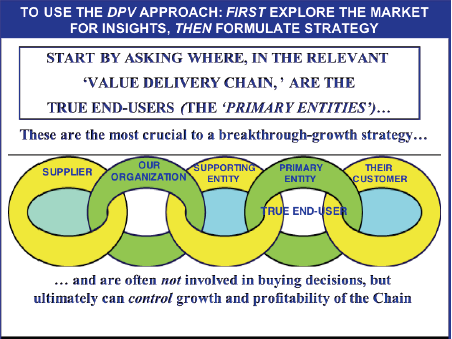
Primary Entities Understanding the identity of the primary entities – those that will be most pivotally impacted by the organization and can most impact its success – is far more important than understanding the desires of the entities closest to the organization. The paper company and similar industrial plants were primary entities in Chevron’s chain. Intel and Microsoft understood that the corporate user of PC’s, and not IBM, was the primary entity in their value delivery chains. The organization must determine its own role in working with the other players in the chain to deliver the appropriate Value Proposition to the primary entity in the chain. The organization must also determine the appropriate value delivery actions for the entire chain to undertake.
Supporting Entities Then, the organization must consider how to motivate the other entities – the intermediaries, its own suppliers, important off-line entities, and others in the chain. To motivate these other entities, the business may need to choose and deliver supporting Value Propositions to them. Any manufacturer who distributes through retailers, for example, needs to choose the right Value Proposition to the actual user of the product. For this proposition to be delivered, the manufacturer must play a role (e.g., designing, making, perhaps advertising the product) but so must the retailer (e.g., making the product easily available). To motivate that retailer, the manufacturer must show the retailer the resulting experiences they will receive for playing this role. The whole task of managing a business thus must encompass understanding, sometimes redesigning, and delivering value across an often complex value delivery chain.
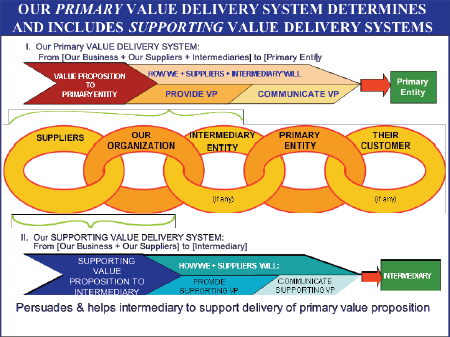
Stop Listening! Learn To Become Customers Instead
But how should businesses discover and choose the resulting experiences central to the Value Propositions they should deliver, if they are to avoid being either Internally-Driven or Customer-Compelled?
Example: Honda becomes the motorist A team of Honda employees is staked out in a parking lot of a grocery store. From a distance, they videotape scores of consumers performing the same task: loading groceries into the trunk (i.e., boot) of a car. Different cars, different consumers, different grocery bags. Back in Tokyo, Honda engineers and other managers, designing the next model, watch these videos. Some consumers are seen struggling to get the bags into the trunk. Some arrange their plastic bags to keep them from tipping over. At night, some peer into the trunk as they try to arrange bags in the back of the trunk. A few pause, rest a bag on the edge of the trunk wall, and then have to lift the lid again after it partly closes. For a few others, the cart slowly rolls a few feet away from the car as they load the trunk. For some, the whole process goes along without a hitch.
These motorists are not telling Honda their trunk needs or their desired benefits in a trunk. They are simply living part of their car experience. Watching these videos, the Honda engineers and other managers vicariously live that experience by putting themselves in the consumers’ shoes. They can see and feel what is imperfect in the consumers’ experiences. Then they can envision a far superior trunk-loading experience for these motorists.
Virtual Videos of Day-in-the-life of Customers A tool we have found very useful for thinking about resulting experiences is to imagine making two contrasting video tapes of a day in the life of the customer. In practice, one does not literally have to make a video to understand a day in the life of the customer today. Asking the customer questions about what they do today is often equally effective, as long as one refrains from asking them what they want. The first (virtual) tape would capture a typical current scenario for the customer under study. What are they trying to accomplish, what obstacles do they encounter and how do they cope with those obstacles? The second (virtual) videotape would show what this scenario would be like if the customer’s business or life were much improved. It tries to construct scenarios that are better for the customer and that the organization could conceivably help bring about.
Yet, uncovering and fully understanding the resulting experiences desirable to potential or current users is not nearly as simple as one would like. Directly asking customers what they want often does not reveal the resulting experiences they would most value but rather only elicits their description of the attributes, features and price they think should be offered by a product or service. It is far more powerful to “become the customer,” that is, to study intensively how the customer lives, asking: “What would it be like to ‘be’ this customer and what would I want, as an end-result scenario, if I were that customer? What does this imply our business ideally should do to improve the lot of this customer? Could we do that profitably and better than competition?”
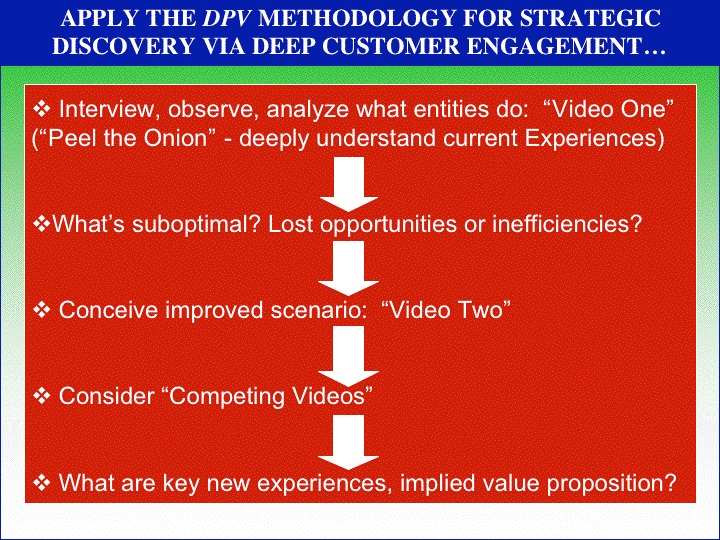
Identifying Value-Delivery Options: Key First Step In Formulating Strategy
Identifying Value Delivery Options and Market Space – Using the DPV perspective, the first step in formulating strategy is to identify and assess the value delivery options the organization may have. These value-delivery options are the possible, potential businesses – Value Delivery Systems – that the organization could pursue. Ultimately, the design and choice of the VDS’s the firm will implement constitute the essential task of corporate strategy, as understood in terms of the principles of DPV. The firm’s Value Delivery Systems should be understood in the context of other possible businesses, which may be related. A set of related possible businesses constitutes what we call a market-space, which includes customers, interacting with each other in value delivery chains, and the related Value Delivery Systems possible among them.
An organization considering one or more market-spaces should identify the value delivery options in each. For a given market-space, what would the organization have to do in order to profitably win the business of the customers in it? There typically will be several different, though related, possible businesses in a market-space; strategy formulation should start with identifying and evaluating these options.
A group of customers belongs to a value-delivery option if the business would need to deliver one particular Value Proposition, in essentially the same way, to them. After identifying the value-delivery options (perhaps some obvious, some latent) in a market-space, an organization can decide in which options (if any) it can profitably execute the required VDS better than competition.
Avoid Imitation-Inspired thinking Many organizations are overly distracted by competitors, in the effort to “win.” They frequently measure what competitors do and worry greatly if they don’t match or exceed these competitors’ actions. This game is easy to play without any reference to the experiences most desirable for customers. Competitive analysis in the DPV context first defines the resulting experiences some set of customers would most value. Then DPV asks, “Who among the possible competitors is able to deliver the most valuable combination of these resulting experiences to these customers?” A business wins by delivering a superior Value Proposition, not by being superior to competitors in some other respect.
A Value-Delivery-Driven view of Capabilities The organization must then determine, for each value-delivery option, what key capabilities would be required by the VDS, what new capabilities the organization will have to build, at what cost and with what probability of success, in order to deliver a proposition superior to competing alternatives. This evaluation is not the same as asking, “What are our business’s core competencies today?” In some cases, more dramatic profitable growth can be attained by building a new set of competencies, or capabilities. Sometimes, because of discontinuities in the marketplace, one has little realistic choice. Understanding current competencies may help one decide what market-spaces to evaluate in the first place; but learning how to build new competencies is unavoidable in a rapidly changing world, as countless companies have painfully discovered.
Different Approach than Conventional Segmentation Based on this evaluation, the organization selects the businesses it will conduct, thus determining the organization’s strategy in that market. This approach of identifying value-delivery options differs from the Internally-Driven methods of segmentation commonly employed. Segmentation is frequently treated as a marketing technique, useful mainly to find ways to better sell what an organization has already decided to make. Value-delivery option identification is conducted to discover what products and services should be made.
Don’t Segment Backwards – Think Value Delivery First Conventional segmentation approaches also divide customers based on variables such as demographics, or product usage, that may or may not have anything to do with the actual requirements of profitable value delivery to those customers. The conventional approach to clustering customers by market segmentation is thus backwards. It divides customers by numerous variables without knowing how they vary by the one variable that matters strategically – what VDS is appropriate to them. The DPV approach first divides customers according to the VDS that would be most appropriate to winning their business, regardless of their demographics or other variables that may describe them. DPV then determines what demographic or other variables, if any, may describe the customers in each option, as this information may be helpful to understand and reach customers in each option.
Real Business Plans – Committing And Executing
Having evaluated an organization’s value delivery options in a given market-space and having chosen the estimated most profitable combination of those options, it is time to formally commit to this choice. All decision making devices, including business plans, budgets, asset allocations, product, human resource and marketing plans, should be explicitly, rigorously determined by the VDS’s to which they belong or must support.
Organization Structure Implications This often also means restructuring. Though many people rightly want to avoid pointless restructurings, the simple fact is that a great many organizations are not structured as VDS’s. Typical is to be organized by products as business units when in fact the right Value Propositions require bundles of products to be delivered in an integrated fashion. Even more primitive versions of the problem show up as functionally structured organizations where manufacturing, marketing and engineering act in no more integrated fashion than a set of loosely related business units. Restructuring to clarify accountability and to integrate functions around the appropriate Value Propositions is often unavoidably crucial.
A Winning Business/Value Delivery System (VDS)
Organizations must evaluate whether the designed Value Delivery System constitutes a winning business. The checklist below suggests questions by which to determine whether a Value Delivery System will generate wealth for a firm and thus whether it should be implemented.
Checklist For A Winning Business – A Winning Value Delivery System (VDS)
- WILL THIS VDS DELIVER SUPERIOR VALUE (perceived by intended entities)?
- HOW MUCH REVENUE would we expect from this VDS?
- CAN WE BUILD THE CAPABILITIES NEEDED to implement this VDS?
- WHAT TOTAL COST WILL WE INCUR? (Includes on-going operating costs plus those of building new capabilities, and the cost of capital)
- HOW MUCH PROFIT would this business/VDS generate?
- WHAT IMPACT ON OUR OTHER BUSINESSES would it have? (Includes possible conflicts and/or synergies with our other businesses)
- WHAT IMPACT ON LATER TIMEFRAMES would it have? (Does it facilitate a longer-term, more profitable VDS? Or compromise our future?
- WHAT DISCONTINUITIES may impact its success and sustainability?
- HOW DOES THIS VDS COMPARE TO OUR OTHER OPTIONS?
- IN NET: IS THIS A GOOD VDS? Considering both short- and long-term, will this VDS generate more wealth for our firm than not implementing it?
Conclusion
Far less traveled than the Internally-Driven and Customer-Compelled paths, the value delivery path is for those committed to finding breakthrough profitable growth opportunities. But one must be willing to change, not just repeat platitudes about value. DPV calls for fundamentally changing how organizations:
- Define their businesses;
- Adopt success-criteria;
- Structure their organizations;
- Identify, explore, assess and choose strategic options;
- Study and understand customers;
- Analyze competition;
- Develop and manage all resources, processes, and functions.
Getting Started
To begin the journey, leadership should assess the extent to which their organizations understand these concepts of value delivery, versus relying on Internally-Driven and Customer-Compelled thinking. Leaders can begin by answering:
- Does our organization, including senior leadership and all functional managers, know what Value Proposition(s) the organization delivers today? Do we know the extent to which these propositions are sustainably superior and profitable?
- Has the organization deeply studied, not superficially surveyed, the business/life of important entities in the relevant value delivery chain? Does management have quantitatively solid insights into how these various customers’ current experiences could be greatly improved in ways the organization may be able to make happen?
- Has the organization chosen the one or more propositions which will make up its strategy in the near and longer term future?
- If so, is there more than lip service rendered to these propositions? Is there a Value Delivery System for each – a detailed description of what each function, resource, and process must do to provide and communicate the proposition?
- Are the organization’s efforts to invest in and build its future capabilities entirely focused on these designed Value Delivery Systems?
DPV is realistic To truly understand customers and thus formulate and execute business strategy that can accelerate profitable growth, managers must design each of their businesses around a disciplined choice of a winning Value Proposition. DPV offers managers guidance, in detailed practical terms, for making it happen.
